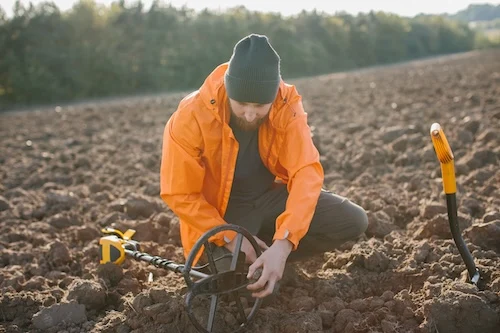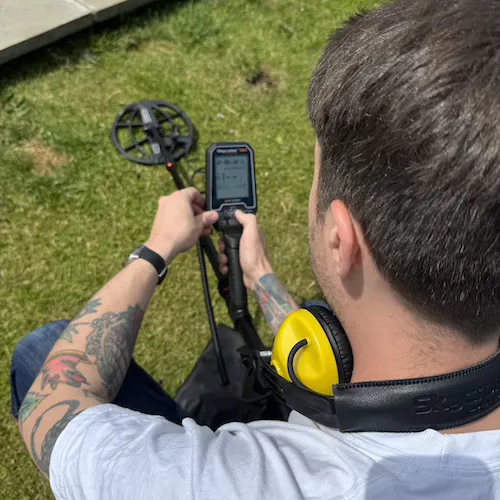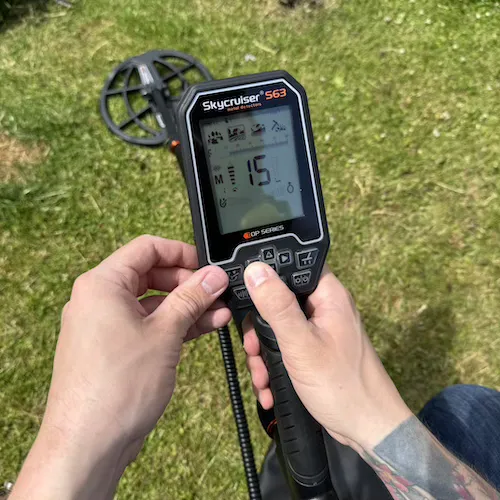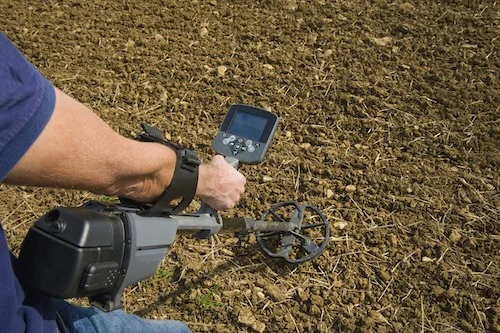Metal Detector Ground Balance Explained For Beginners

Written by Piotr Lesniewski
Detectorist • Scotland
As an Amazon Associate we earn commission from qualifying purchases. Read our full Affiliate Disclosure.
Have you ever spent hours metal detecting only to be frustrated by constant false signals? Your detector’s Ground Balance setting might be the culprit. This crucial calibration helps your device distinguish between valuable finds and mineralized soil that triggers unwanted alerts.
Whether you’re hunting for coins at the beach or searching for relics in a field, mastering Ground Balance will significantly improve your success rate and transform your treasure hunting experience.
Key Takeaways
- Ground balancing calibrates your metal detector to ignore naturally occurring minerals in soil while still detecting actual treasures.
- Types include preset, manual, automatic, and tracking ground balance, each with specific advantages for different detecting scenarios.
- The proper pumping motion involves raising the coil 6-8 inches above the ground and lowering it repeatedly in a steady rhythm.
- Ground balance should be performed at the beginning of each session, when changing locations, and when detector behavior becomes erratic.
- Highly mineralized soils and saltwater beaches require more frequent ground balancing and possibly specialized detector modes.

What is Metal Detector Ground Balance?
Ground balance is the critical calibration feature that separates successful treasure hunters from frustrated hobbyists. It’s the process of tuning your detector to ignore naturally occurring minerals in the soil while remaining sensitive to actual treasures.
The earth isn’t neutral—it contains iron particles, salt, and various minerals that your detector will register as signals.
Without proper ground balancing, your machine treats the entire ground as one massive, noisy target, drowning out the valuable finds you’re actually seeking.
When you ground balance your detector, you’re essentially telling it, “This is what the earth sounds like here—ignore these signals.” This calibration allows your equipment to filter out the “ground noise” and focus on detecting the real targets—coins, jewelry, and relics—hidden within the soil.

Why is Metal Detectors Ground Balance So Important?
Ground balance is the foundation that enables your metal detector to reach maximum detection depth while maintaining stable operation in varied terrain.
You’ll experience more accurate Target ID readings when your detector properly distinguishes between mineralization and valuable targets.
Proper ground balance settings also reduce operator fatigue by eliminating the constant false signals that force you to repeatedly dig empty holes.
Maximum Detection Depth
A properly ground balanced detector significantly impacts how deep you can detect valuable targets. If your detector constantly battles ground signals, it wastes processing power fighting mineralization instead of identifying deeper targets.
Think of it like trying to hear a whisper in a noisy room – the background noise (ground minerals) drowns out the faint signals from deeper objects.
A well-balanced machine, however, effectively “cancels out” the ground noise, allowing the detector to focus its sensitivity on what matters – your potential finds. This means you’ll discover targets several inches deeper than with an improperly balanced detector.
Stable Operation
Maintaining a stable, quiet detector is perhaps the most immediate benefit of proper ground balancing.
When your detector isn’t properly balanced, you’ll notice it becomes excessively “chatty,” constantly signaling even when no valuable targets are present. This instability occurs because unbalanced detectors react strongly to natural ground minerals, interpreting them as potential finds.
The constant false signals make it nearly impossible to distinguish between genuine targets and mineral interference.
Accurate Target Identification (Target ID)
Accurate target identification hinges entirely on your detector’s ability to separate genuine finds from surrounding minerals. When ground mineralization interferes with your detector’s signals, you’ll receive unreliable Target ID readings.
Without proper ground balancing, those valuable coins or relics you’re hunting could register as worthless trash or vice versa. The minerals in soil essentially “confuse” your detector, causing it to misinterpret what’s actually beneath the coil.
Reduced Fatigue
Metal detecting becomes physically and mentally exhausting if you’re constantly fighting with a chattering, unstable detector. Proper ground balance transforms this experience.
When your detector is properly balanced, you’ll notice a significant reduction in mental fatigue as you’re no longer forced to analyze every fluctuation or false signal.
The machine operates smoothly, providing clear, reliable feedback. This stability means you’ll stay fresher longer, allowing for extended hunting sessions without the mental burnout.

How Does Metal Detector Ground Balancing Work?
Ground balancing actually functions as a calibration process for your detector’s discrimination system.
When you perform this essential procedure, you’re essentially teaching your detector to recognize the unique mineral signature of the ground you’re searching. Your detector creates an internal electronic filter based on this information.
This filter works by canceling out or ignoring the specific signals produced by naturally occurring minerals in the soil. With these ground signals filtered out, the detector can now focus exclusively on what matters most—metallic objects beneath the surface.
Types of Ground Balancing
Metal detectors offer several ground balancing options that you’ll need to understand for optimal performance. You can choose between preset/fixed settings, manual ground balance, automatic GB, or tracking ground balance that continuously adapts to changing soil conditions.
Preset/Fixed Ground Balance
Beginners often encounter preset ground balance settings on entry-level detectors. These systems come with factory-calibrated values designed to work adequately in typical soil conditions. You’ll appreciate the simplicity—there’s nothing to adjust.
However, preset ground balance has significant limitations. When you’re hunting in areas where soil mineralization differs substantially from the factory’s “average” setting, your detector’s performance will decline.
Manual Ground Balance (Manual GB)
For those seeking greater precision, manual ground balance provides complete control over your detector’s response to soil minerals.
This method requires you to find a metal-free patch of ground where you’ll “pump” your search coil up and down while adjusting the GB control until ground noise is minimized or eliminated.
When done correctly, you’ll hear either silence or a consistent, faint hum throughout the pumping motion.
While manual GB delivers optimal performance, it does require practice to master.
Automatic Ground Balance (Auto GB / AGB)
Automatic ground balance (Auto GB) offers a streamlined alternative that most modern detectors now include. This feature automatically samples the mineralization and sets an appropriate balance point without requiring technical knowledge.
To use Auto GB, simply press the designated button and pump the coil over a clean patch of ground for several seconds. The detector analyzes the ground signals and locks in the optimal setting.
Though Auto GB works effectively in most environments, it may not achieve the perfect precision of a well-executed manual balance in extremely challenging ground conditions.
Tracking Ground Balance (Ground Track)
Tracking Ground Balance takes the convenience of Auto GB to the next level with continuous, real-time adjustment capabilities. Your detector constantly monitors ground mineralization while you hunt, making small ongoing adjustments automatically.
This feature shines in areas with variable mineralization, such as fields with patchy soil types or beaches with black sand streaks.
However, tracking comes with tradeoffs. In very stable ground, it might sacrifice slight depth compared to a perfectly set manual GB. There’s also a small risk that extremely slow sweeping over deep, tiny targets might cause the detector to “track out” faint signals.

When to Ground Balance Your Metal Detector
You should ground balance your metal detector at the beginning of every hunt and whenever you move to a new area with different soil conditions. If your detector starts giving false signals or becomes unusually noisy, it’s time to rebalance.
At the start of EVERY metal detecting session
Ground balancing should be performed at the beginning of every detecting session. This initial calibration sets the baseline for your entire hunt, ensuring your detector is tuned to the specific soil you're on from the very beginning.
When moving to a new field or a significantly different area within a site
Moving between different hunting locations requires additional ground balancing. When you transition from one terrain type to another, soil mineralogy often changes dramatically.
For instance, shifting from a dry field to a damp pasture significantly alters the ground’s conductivity. Similarly, moving from an inland site to a beach introduces highly mineralized wet sand. These environmental transitions demand recalibration.
If your detector becomes noticeably noisy, “chatty,” or starts giving false signals
When your previously smooth-running detector suddenly becomes erratic, it’s often signaling that ground conditions have changed.
These false signals that seem to originate from the ground itself are a clear indicator that your ground balance setting is no longer matching the mineralization in your current location.
Don’t ignore these symptoms – they’re your machine’s way of telling you it needs rebalancing.
Periodically during a long hunt (e.g., every hour or two)
Even during seemingly stable hunts, a regular ground balance check every hour or two can make a substantial difference. Environmental factors can subtly shift over time as you move across terrain—moisture levels may change, and soil composition might vary without obvious visual cues. This habit is particularly important if you’re using manual or standard automatic ground balance settings.
If you change search coils
Changing search coils on your metal detector necessitates an immediate ground balance adjustment. Each coil, even those from the same manufacturer, responds differently to mineralization in the soil. You’ll need to repeat your full ground balancing procedure with the new coil installed, as its unique electromagnetic properties will interact differently with the ground.

How to Ground Balance (General Guide – always check your manual!)
To ground balance your metal detector effectively, you’ll first need to locate a “clean” spot without metal objects. Then use a “pumping” motion by raising and lowering your search coil above the ground. Depending on your detector model, you’ll either adjust settings manually, press a button for automatic ground balancing, or engage the tracking feature.
Find a “Clean” Spot
The first critical step is finding a “clean” spot of earth that contains no metal objects. Attempting to ground balance over buried metals will give you incorrect settings. Scan the area carefully, searching for a location where your detector remains quiet. If you’re having trouble, use your pinpointer to verify the spot is clear.
The “Pumping” Motion
Ground balancing requires a consistent “pumping” motion. Hold your search coil parallel to the ground at your normal sweep height (1-2 inches). Smoothly lift the coil to about 6-8 inches, then lower it back down.
You’ll need to maintain a steady rhythm as you repeat this up-and-down movement. Aim for one complete pump every 1-2 seconds.
Adjusting (Manual GB)
Once you’ve mastered the pumping motion, manual ground balancing requires careful adjustment of your detector’s GB control knob while monitoring audio feedback. Continue making small adjustments while repeating the pumping motion until you achieve minimal or no audio change as the coil moves up and down.
Initiating (Auto GB)
Most modern detectors feature an automatic ground balancing function. To use auto GB, press and hold the designated button while pumping the search coil. Continue this pumping action until your detector signals completion—typically with a beep, tone, or display message.
Engaging (Tracking GB)
While Auto GB provides a one-time solution, Tracking GB continuously adjusts to changing soil conditions. To enable it, navigate to your detector’s menu and toggle the tracking function to “on”. Some detectors require you to perform an initial Auto GB before tracking becomes effective.

Ground Conditions and Their Impact On Your Metal Detectors Ground Balance
Different ground conditions can dramatically affect your detector’s performance. You’ll find mild ground needs minimal compensation, while highly mineralized terrain demands more aggressive settings. Saltwater beaches create unique challenges for standard ground balance configurations.
Mild Ground
Mild ground conditions are characterized by low mineralization, making them ideal for treasure hunting. In mild ground, your detector operates with remarkable stability and consistency. This stability typically allows you to crank up your sensitivity settings higher than normal, enabling you to detect deeper targets.
Highly Mineralized Ground
Highly mineralized ground is found in areas with red clay soils or volcanic rock formations. The significant concentrations of iron, salts, and other conductive minerals create persistent interference. When hunting in highly mineralized ground, you’ll need to ground balance more frequently and likely reduce your sensitivity settings to minimize false signals.
Saltwater Beaches
Saltwater beaches create some of the most challenging environments. The wet salt creates a highly conductive signal that can overwhelm standard VLF detectors. When detecting on saltwater beaches, you’ll need to accurately ground balance your machine specifically for the salt mineralization. Many modern detectors offer dedicated “Beach Modes” that automatically adjust for these conditions.

Ground Balancing Relationship with Other Metal Detector Settings
Your ground balance setting interacts dynamically with sensitivity, discrimination, and target ID settings. Higher sensitivity requires more precise ground balancing. Proper ground balance leads to improved discrimination and more reliable target ID readings.
Sensitivity (Gain)
Proper ground balance is essential to running higher, stable sensitivity levels. Without it, mineralization will cause your detector to become “noisy” and unstable, forcing you to reduce sensitivity and diminishing your detection depth.
Discrimination & Target ID
Ground balancing plays a significant role in how accurately your detector identifies targets. When your detector isn't balanced, minerals can generate false signals or distort Target ID readings. More concerning is that the noisy ground signal can completely mask legitimate target signals, causing you to miss potential finds altogether.

Key Tips for Metal Detector Ground Balancing
You’ll save yourself countless hours of frustration by thoroughly reading your detector’s manual. Mastering manual ground balancing through practice will sharpen your skills. When you encounter challenging soil conditions, don’t hesitate to re-balance.
ALWAYS READ YOUR DETECTOR’S MANUAL!
Although every metal detector has unique features, there’s no substitute for thoroughly reading your detector’s manual. Your device’s documentation contains specific instructions tailored to your model’s ground balancing capabilities and limitations.
Don’t skip over technical sections—they contain valuable insights that can significantly improve your detecting success.
Don’t Skip It
Many detectorists skip ground balancing, thinking it’s unnecessary. This is a critical mistake. When you bypass this step, your detector can’t properly distinguish between mineralization and actual targets, leading to false signals and missed finds. Taking those extra two minutes to properly ground balance can dramatically improve your detection depth and accuracy.
Practice Manual GB (if your detector has it)
Mastering manual ground balance (GB) offers superior control in challenging soil conditions. This skill allows you to fine-tune your detector’s response more precisely than automatic modes can. Dedicate time to developing this skill; your persistence will be rewarded with improved depth and discrimination.
If in Doubt, Re-Balance
Ground balancing isn’t a one-and-done procedure. As you move across different terrain, soil conditions change. When your detector begins to act erratically, make re-ground balancing your first troubleshooting step. This simple action often resolves performance issues instantly.
Understand Hot Rocks
“Hot rocks” are naturally occurring mineral formations that can trigger your detector just like a valuable target. When you receive a repeatable signal but uncover only a rock, perform a ground balance right over the rock. If the signal disappears, you’ve likely encountered a hot rock, saving you from unproductive digging.
A Clean Spot is Key
When performing ground balance, finding a clean spot free of any metal is absolutely critical. Any metal in the ground where you’re attempting to balance will throw off your readings. Take a moment to verify your balancing location with your pinpointer to ensure your settings truly reflect the mineralization, not hidden metal.
Conclusion
You’ve now mastered the fundamentals of ground balancing your metal detector. Remember, it’s not just a setting—it’s your key to finding more treasures in mineralized soils. By understanding when and how to adjust your GB, you’ll maximize your detector’s performance and reduce frustrating false signals. Don’t forget to recalibrate when conditions change, and you’ll be unearthing more finds in no time!
Author Profile

Piotr Lesniewski
"Digging up the past, one signal at a time."
Polish-born, Scotland-based, and obsessed with the beep. My passion began decades ago, exploring fields with my Dziadek (grandfather). Now, with over 10 years of digging under my belt, I'm here to share everything I've learned—unfiltered and unbiased—to help you unearth your own piece of history. No sales pitches, just real field experience.